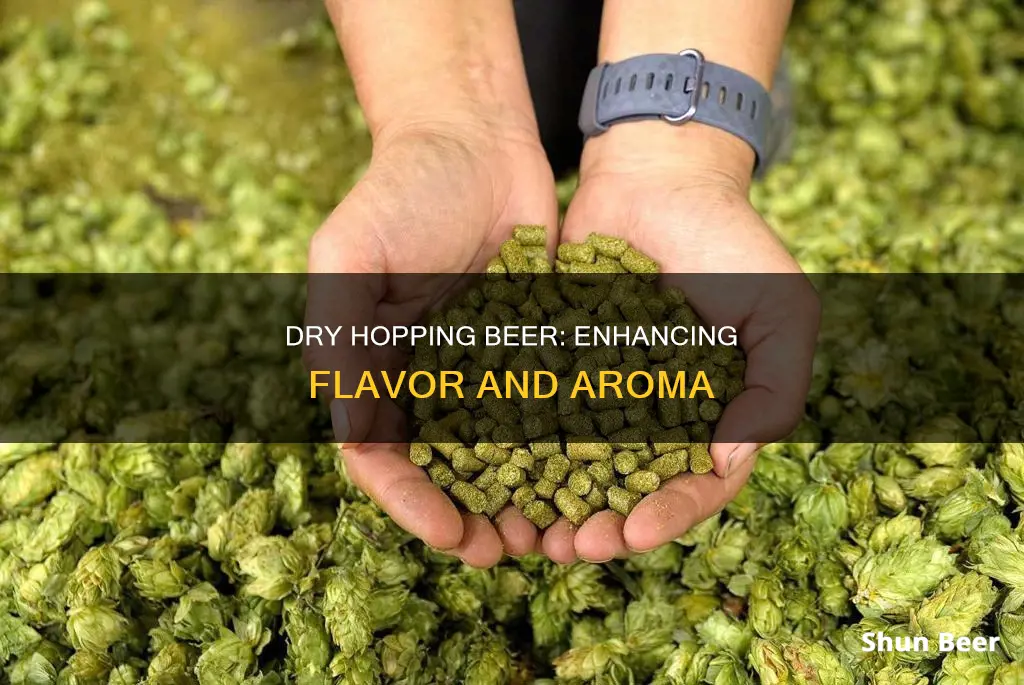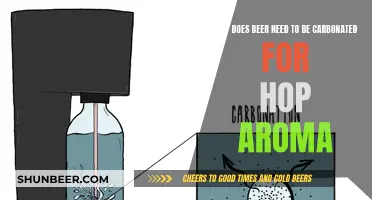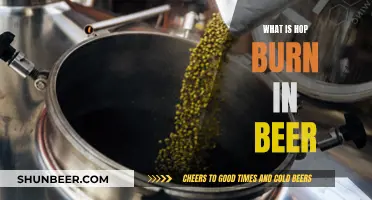
Dry hopping is a brewing technique used to add aroma and flavour to beer without increasing its bitterness. The process involves adding hops during the fermentation stage, rather than during the boil, to preserve the volatile oils that give the beer its aroma and flavour. This technique is particularly associated with pale ales and IPAs.
| Characteristics | Values |
|---|---|
| Purpose | To introduce fresh hops aroma to any style of beer, but especially pale ales and IPAs |
| Timing | During or right after primary fermentation has finished |
| Type of hops | Dried whole leaf or T-90 pellets |
| Bitterness | Does not add bitterness to beer |
| Alpha acids | Hops contain compounds called alpha acids which, when heated during the boil, undergo isomerization to provide hop bitterness in beer |
| Volatile oils | Preserves the delicate volatile oils that produce flavour and aroma |
| Whole leaf vs pellet | Whole leaf hops tend to float on top of the liquid, while pellet hops disintegrate into a hops sludge that sinks to the bottom |
| Bagged hops vs loose hops | Loose hops are preferred by some as the aroma seems to be stronger, but bagged hops are easier to retrieve |
What You'll Learn

Dry hopping preserves volatile oils, enhancing flavour and aroma
Dry hopping is a technique used by brewers to enhance the flavour and aroma of beer. Hops play a significant role in the brewing process, contributing bitterness, flavour, and aroma. While bitterness comes from the alpha acids in hops, flavour and aroma are derived mainly from volatile oils. These oils are volatile and can boil out of the wort quickly, often within 15-20 minutes. Therefore, brewers typically add flavour and aroma hops towards the end of the boil to maximise their impact.
Dry hopping involves adding hops late in the brewing process, usually during or after primary fermentation, to intensify specific aromas and flavours without increasing bitterness. This technique preserves the delicate volatile oils responsible for flavour and aroma, which would otherwise be lost during a boil. By avoiding the boiling process, dry hopping ensures that these oils remain intact, imparting a floral hop essence and an intense flavour desirable in hoppy beer styles like pale ales and IPAs.
The term "dry hopping" originated with British brewers, who added hops to casks shortly before shipping. Today, dry hopping refers to any hop addition after the wort has cooled, and it can be done in the primary or secondary fermenter or directly in a keg. Brewers have the option to use whole leaf hops or pellet hops for dry hopping, depending on their preference and availability.
In summary, dry hopping is a valuable technique for brewers seeking to maximise the flavour and aroma of their beers by preserving volatile oils that would otherwise be lost during boiling. By adding hops late in the process, brewers can create beers with enhanced sensory profiles that appeal to consumers.
Choosing Hops for Beer: A Guide to Aromatic Excellence
You may want to see also

Dry hopping doesn't add bitterness to beer
Dry hopping is the process of adding hops to beer during or right after primary fermentation. It is an excellent way to introduce aroma and flavour to the beer without adding bitterness. The hops used are usually dried whole leaf or T-90 pellets.
Hops contain compounds called alpha acids. When alpha acids are heated during the boil, they undergo isomerization, which provides bitterness in the beer. Boiling hops for a longer period of time leads to more isomerization and a more bitter beer. However, dry hopping does not involve boiling the hops, and therefore does not add bitterness to the beer. Instead, dry hopping preserves the delicate volatile oils that produce flavour and aroma.
Dry hopping can even make beer less bitter. This is due to the change in hop acid composition that takes place when dry hopping. Iso-alpha acids, which are not extremely soluble, are responsible for the bitterness in beer. When dry hopping a high IBU beer, the hop pellets absorb and remove significant amounts of iso-alpha acids and add humulinones and alpha acids, which are soluble and less bitter. This change in hop acid composition can reduce the bitterness intensity of the beer.
However, it is important to note that some studies have found that dry hopping can add bitterness to beer, especially when using very high levels of hops. This is because dry hopping can increase the concentration of humulinones, which can create about two-thirds as much bitterness as iso-alpha acids. Additionally, pellets have more humulinones than whole-flower hops because the lupululin glands are broken.
In conclusion, while dry hopping does not typically add bitterness to beer, it can enhance the flavour and aroma of the beer by preserving volatile oils.
Sedative Hops: Brewing Relaxing Beers With These Hops
You may want to see also

Dry hopping can be done with whole leaf or pellet hops
On the other hand, whole leaf hops will take up more space in the fermenter and absorb more beer, resulting in a lower overall yield. They can be more difficult to get into and out of the carboy, especially if you use a bag, and they may not extract as much oil as pellets since it takes longer for the oils to be released. However, some brewers prefer the flavour and aroma of whole leaf hops, and they don't cause the same foaming issues as pellets.
Ultimately, the choice between whole leaf and pellet hops for dry hopping depends on personal preference and the specific requirements of the brewing process.
Sleepy Time: Hops with the Most Sedative Powers
You may want to see also

Dry hopping can be done in the primary or secondary fermenter
Dry hopping is the process of adding hops to beer between fermentation and packaging. The term originated with British brewers who would add hops to the cask shortly before shipping. Today, dry hopping refers to any addition of hops after the wort has been cooled. This can be done in the primary fermenter, the secondary fermenter, or by adding hops directly to a keg.
The primary fermenter will work for dry hopping, but it is not considered optimal. This is because the bubbling of CO2 and the agitation of the wort during primary fermentation can take away some of the hop aroma, defeating the purpose of dry hopping. However, some brewers still choose to dry hop in the primary fermenter and simply add more hops to compensate.
The secondary fermenter is generally considered the best place for dry hopping. By this stage, most of the fermentation is complete, so the alcohol and low pH help to prevent any bacterial growth on the hops. Additionally, the vigorous CO2 activity of the primary is finished, so the aroma of the hops won't be affected. One potential challenge with dry hopping in the secondary is getting the hops into and out of the narrow neck of a glass carboy. This can be avoided by using a bucket with a large opening or by simply dumping the hops into the carboy without a bag.
The final option is to dry hop directly in the keg. This method requires the use of a muslin or cheesecloth bag to contain the hops and prevent them from being sucked into the system. One concern with dry hopping in the keg is the extended duration of contact between the hops and the beer, which some brewers feel can lead to a "grassy" flavor after a few weeks. However, others disagree and claim that this has not been their experience.
Hops in Beer: Necessary or Overrated?
You may want to see also

Dry hopping can be done with loose hops or in a bag
Dry hopping is the process of adding hops to beer after the wort has been cooled. The technique can be traced back to British brewers who would add hops to the cask shortly before shipping. Today, dry hopping can be done in the primary or secondary fermenter, or by adding hops directly to a keg.
When it comes to dry hopping, brewers have the option of using loose hops or hops contained in a bag. There are advantages and disadvantages to both methods.
Loose hops provide better exposure to the beer, which can result in improved aroma and flavour. However, this method can make it more difficult to separate the hops from the beer when racking to the bottling bucket or keg. This is especially true when using a glass carboy with a narrow neck as a secondary fermenter.
Using a bag for dry hopping can make it easier to retrieve the hops and separate them from the beer. It also helps to ensure that no hops end up in the glass when serving. However, bags can reduce the surface area of the hops exposed to the beer, potentially impacting the extraction of oils. Bags can also be difficult to remove if they swell up and get stuck in the neck of a carboy.
Ultimately, the decision to use loose hops or a bag for dry hopping depends on the brewer's preferences, equipment, and specific circumstances. Some brewers may choose to experiment with both methods to determine which works best for their particular setup.
Hops and Hues: Unveiling the Color Mystery in Beer Brewing
You may want to see also
Frequently asked questions
Dry hopping is the process of adding hops during or right after primary fermentation. This technique adds aroma and flavour without any bitterness to the beer.
Dry hopping is a great way to introduce a fresh hops aroma to any style of beer, but it is especially used for pale ales and IPAs. The technique helps to preserve the delicate volatile oils that produce flavour and aroma, giving the beer a mouth-watering aroma.
There are numerous ways to dry hop beer. You can dry hop in the secondary fermentation stage, either by adding loose hops or by using a muslin bag. You can also dry hop during active fermentation, which is believed to enhance the flavours and aroma of the finished product.







